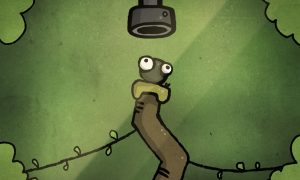
There are games that define a generation and they typically come at the end of the product lifecycle. They stand out as pushing the hardware beyond anything we’d seen prior and they have storylines that you’ll remember for all time. Games like Chrono Trigger, Final Fantasy VII, Metal Gear Solid, and Grand Theft Auto San Andreas are great examples of these sorts of titles. On the PlayStation 3 it is the Uncharted series we turn to when we want to impress somebody with the raw power of that platform. Somehow, as amazing as the previous Uncharted games were, they have been supplanted. The Last of Us is, hands down, the best game on the PlayStation 3. As much as I really try not to write “love letter” type reviews, brace yourself – this game is every bit as amazing as we’ve been lead to believe. With the PlayStation 4 launch looming large on the horizon, Naughty Dog has given us the best reason to own a PlayStation 3.
My review will be spoiler free beyond a few set pieces that are absolutely required. This is a game you must experience and it’d ruin the incredible story to tell you more than that.
[singlepic id=12716 w=320 h=240 float=left]The story begins well before the incursion of the plant infestation referred to in our recent hands-on preview. It’s Joel’s birthday and he’s celebrating with his family. Awoken by an urgent phone call , the next 15 minutes are some of the most cinematic, suspenseful, and edge-of-your-seat moments I’ve ever seen in all my years of gaming. Directly in the middle of the outbreak of the infected, Naughty Dog sets the stage for what has turned out to be an incredible game. Movies rarely do it this well.
The game proper picks up a full 20 years into the outbreak. Joel and Tess, a pair of tough-as-nails local smugglers, have settled in the city of Boston – a fully-quarantined city. A recent smuggling effort has gone wrong and now they have to sneak outside of the zone to try to get made whole on their arrangement. Sneaking past flesh-eating infected, trying to not inhale spores to become infected themselves, and dodging soldiers as they sneak outside the city walls is just part of their day; and that’s before they face off against what’s left of what you might call ‘society’. Dens of cuthroats, thieves, and murderers are all that await them should they even arrive at their destination – this is the new world we live in, and it is not kind.
Cordyceps – it’s going to kill us all.
[singlepic id=12715 w=320 h=240 float=left]It is not much of a spoiler to say that you end up with young Ellie in your party. Joel is tasked with getting her to a group called the Fireflies. This group constitutes the last resistance to the military quarantine rule, and the last group of people still trying to save the world from the cordyceps-infected creatures that inhabit so much of it. Before we get into the mechanics of the game I need to tell you a horrific thing – cordyceps infection is real. There is an infection that takes over the minds of ants, snails, and even spiders, sprouting fungal leaves from their flesh and taking over their minds. This malady self-perpetuates by making the animals do things that will get them eaten by larger predators, spreading the infestation further through the natural digestion / excretion process of birds and other creatures. As a great primer before you play this game, please take a moment and check out the video below. If you are horrified and suddenly worried what happens when this jumps to animals higher in the food chain, you’ve got the right mental preparation for The Last of Us.
[youtube]http://youtu.be/XuKjBIBBAL8[/youtube]
“I reckon it’s got something to do with that girl.”
There has been no shortage of fantastic looking titles coming to the PlayStation 3, and The Last of Us maintains that solid tradition. Vast amounts of improvements over Uncharted 3’s engine to bring The Last of Us alive, and it shows in nearly every way. Characters realistically put their hand on boxes and walls as they brace for a rest. Ducking and sneaking in stealth mode looks hard on the knees and very realistic. Getting popped with a round may send you reeling backwards, forcing you to scramble back to your feet when hit. Hand-to-hand combat brings blows that land with a solid impact, each swing carrying the weight and intent to a bloody conclusion. As fantastic as all of this is, it pales in comparison to the facial animation.
Uncharted has always featured a lot of feeling and character in the faces of the people in the game, but The Last of Us takes that to a whole new level. Joel’s beard isn’t painted-on, instead featuring a mass of individual strands of hair. Similarly, the crows-feet around his eyes wrinkle and move as he talks. Subtle conveyance of emotion in the narrowing of the eyes, tightly pursed lips, or even a pleading look on Ellie’s face pull you in and creates a connection that extends beyond the story.[singlepic id=12713 w=320 h=240 float=right]
Taking on a foe sends blood spatter across nearby objects, and killing them causes them to bleed out. My complaint is that the result is always the same – a circular pool that spreads out under them. I don’t expect a dynamic blood pool, but when the body disappears to save on memory usage, it breaks immersion.
Much of The Last of Us is spent in or around in the shadows. Joel has an Army-issued flashlight he can hang on his vest, so getting the lights to dance around objects in the environment is crucial. Volumetric lighting, sunlight streaming through trees, bugs, lint, and spores dot your vision. The environment and lighting is just warm and fantastic. There is really only one area that stuck out like a sore thumb – water edges. Water looks realistic and gorgeous, but when you get into situations where water is rolling off objects and churning the water looks a little unrealistic. I think the idea was to create a bit of a sea foam, but it just doesn’t come together that way, sticking out against the far better bodies of water further away from the edge.
[singlepic id=12711 w=320 h=240 float=left]Like any Havok-powered game there is some jittery wonkiness and the occasional texture tearing or odd seaming, but it’s so minor as to be a non-issue. It’s hard to believe how fantastic the game looks and somehow still hold down a solid framerate.
Survival, not just survival horror.
I’ve recently completed several reviews in the survival horror category. That genre has not evolved much in the last decade, still relying on cheesy scares, flashlight batteries that last seconds, monster closets, and restricted ammunition wrapped around thinly-veiled storylines. Simply starving the player of provisions and ammunition doesn’t suddenly make a game ‘survival horror’. The Last of Us doesn’t suffer from this same affliction.
Naughty Dog equipped Joel with tools that support survival horror as a framework instead of a setting that is laid on top. Since he has spent the last 20 years scraping by in a hostile world, he is used to scrounging for supplies. Rags, scissors, sugar, bindings, explosives, bats, pipes, machetes, and other items are scattered throughout the world. Combining alcohol and rags lets you create a molotov cocktail, but it is also the same materials needed for a medical kit. He can use a binding and a pair of scissors to turn a simple 2×4 into something far more deadly, but that is one less blade that can be used in a nail-bomb explosive. Balancing offense, defense, and recovery is entirely in your hands, and none of it will give you more ammunition.[singlepic id=12712 w=320 h=240 float=right]
Ammunition is scarce in this game. Rarely will you have a full clip in a pistol or more than a dozen shells for your shotgun. There are no weapons that you might describe as ‘powerful’ – these are ordinary weapons that you might have in your own closet. There are five tool sets to find in the game that allow you to upgrade the various weapons, giving them new abilities (armor piercing, faster reload, larger clips), making all the difference when you are down to just 4 bullets and every round counts.
Stealth is an absolutely crucial element to the survival horror genre. The most recent Tomb Raider title got it right and it made for an incredibly immersive experience. Given that some of the infected (and all of the humans you might encounter) use echolocation (“Clickers”, as they are called) to find you, so the mechanic for The Last of Us gives you a view that allows Joel to see silhouettes of his enemies as well as any noise he or they might be making. This means stepping on a twig, crushing glass underfoot, or accidentally moving too quickly can set them off, sending them rushing to rend your flesh. When an enemy is coming close to spotting you, a low rumble turns into a sort of ‘whooshing’ sound that culminates with enemies attacking and calling reinforcements.
[singlepic id=12709 w=320 h=240 float=left]To help keep your fleshy bits intact Joel can also upgrade himself by taking pills that he finds in the environment. (maybe all of this game is a hallucination of the literal hundreds of pills that Joel takes through this whole adventure?) Enhancing his hearing range, reducing weapon sway, or adding additional health, are just some of the examples.
A word of caution – if you are imagining a sanitized world where the threats are near comical, you are going to be absolutely stunned by the savage violence in this game. The Last of Us is rated M, and with good reason. In a world that has degraded to this point you can certainly expect some crass language. Equally matched is the level of violence and horror inflicted by enemies, infected or otherwise. If you thought the ways that Lara Croft could die in the most recent Tomb Raider were shocking, seeing a Clicker tear into your neck or having your eye sockets punctured while your jaw is ripped from your still-screaming skull will be a bit of a shock.
The little things
Before we get to the little things, let’s talk about a big thing – the sound. Music in The Last of Us paints a rich and powerful tapestry for Joel, Ellie, and other characters they encounter to inhabit. The soundtrack is subdued, powerful, or supporting the dialogue at just the right moments to invoke or enhance the emotional connection being conveyed. I also can’t overstate the way that the absence of music also plays a role. Just like truly scary films, silence often represents the calm before the storm, lulling the player into a false sense of security until the silence becomes overwhelmingly noticeable just before all hell breaks loose. I said it before and I’ll say it again – movies rarely do it this well.
If the music sets the stage, the voice actors that stand upon it are equally up to the task. Much like our Adventure Game of the Year from 2012, The Walking Dead, The Last of Us completely snared me with its characters. Absolutely nothing is more important to me than keeping this little girl safe. The way that Joel and Ellie’s relationship evolves over time creates a connection that you will never forget.[singlepic id=12708 w=320 h=240 float=right]
The sound effects in this title have, on more than one occasion, made me turn around and look behind me. Hearing the wind whipping through trees, rain bouncing off of metal overhangs, and the crunching of leaves can only have been captured in the real world – they are that good.
Getting to the little things, there are four difficulty levels for the single player experience – easy, normal, hard, and survivor, which is locked until you complete the game. In addition, there are also four New Game+ modes where you can restart with your upgrades and equipment intact. Additionally, other than the initial loading time there are no loading screens in The Last of Us. Little things like seeing “Restart encounter – 3 minutes ago” as an indicator of how far restarting a botched stealth or action sequence might set you back is a welcome sight. Having to smack / shake your controller when your flashlight begins to flicker like you would if you were tapping it into the palm of your hand show just how much Naughty Dog has put into this game to make it operate like the real world.
[singlepic id=12696 w=320 h=240 float=left]Beyond the items above, there are a bevy of collectables in The Last of Us to find. There are comics that you can find for Ellie, tons of notes that add to the rich storyline, and Firefly pendants in the environment. Additionally, once you beat the game you’ll unlock three render modes like we saw in Uncharted 2 – Black and White, Dreampop, and Old West. There are also 19 skins for multiplayer, many of them nods to previous Naughty Dog titles. For example, Ellie can equip a Jak and Daxter T-Shirt, and Joel has a pretty hipster-envy-inducing amount of plaid and denim to choose from. There are also 15 pieces of concept art you can purchase using cash you earn in the multiplayer game, but these are further gated by the single player game to ensure you don’t inadvertently ruin anything for yourself. These extend the single-player experience and give you yet another reason to tackle the aforementioned New Game+ mode.
The other little things
There are a few issues in The Last of Us that popped up in the 18 hour play through of the single-player experience. Occasionally subtitles will overlap one another, creating spastic and nonsensical conversations. I also ran into one moment where a progression trigger failed to work, leaving me hunting for a path forward for over 30 minutes that would never have appeared had I not restarted the section. The AI, while normally quite smart, occasionally does some very unstealthy things like running directly past a searching enemy or bumping past a foe to run around an obstacle. Thankfully Ellie doesn’t trigger the enemy to attack, so when she decides to hide in plain sight it won’t hurt anything. These little things combined with the Havok-hiccups just breaks immersion a little bit.
Ellie: “What do we do?” Joel: “We make every shot count.”
Normally multiplayer is a bit tacked-on when the single-player experience is this solid. It’s a balance between making either one the focus. The folks at Naughty Dog didn’t settle for less, focusing on both and ensuring neither one was neglected. Getting to play with some fellow press and the team from Naughty Dog made me a believer – let’s dig into some multiplayer mayhem.
Multiplayer comes courtesy of hitting a menu option that says “Factions”. Choosing either Firefly or Hunter, you select whether you want to be part of the organized militia or the ragtag survivors. Beyond this choice you’ll pick from four different classifications – assault, sniper, support or stealth. You can also build up to four different custom loadouts of your own when you get the hang of the game. No matter which faction you pick, the job is simple – take down the other side and collect supplies to keep your crew alive.[singlepic id=12706 w=320 h=240 float=right]
Unlocking additional skills, firearms, and purchasable items, comes from acquiring supplies. Performing actions like downing enemies, executing them, getting revenge, getting a headshot, and other activities generates parts you can spend on weapon upgrades, ammunition, and armor. Supplies also let you buy additional weapons like a hunting rifle, bow, or larger weapons like a burst rifle or semi-auto rifle.
The big items in multiplayer come in the form of purchasables, and all but one of those (the shotgun) is locked in the beginning. These items are deadly and can turn the tide of a fight pretty quickly. Selections include the single-shot scoped “El Diablo” pistol, a military assault rifle, a flamethrower, or the brutally effective machete. These have pretty hefty supply costs, so it’ll take a little time and skill to unlock them all.
Survival skills operate as optional upgrades that give you boosts to your abilities. Sharpshooter reduces scope sway by 25%, whereas Crafter lets you create items 75% faster than normal. Strategist allows you to see when you’ve been marked by an enemy player – a death sentence if you are trying to snipe or act in a stealth role.
[singlepic id=12704 w=320 h=240 float=left]Obviously if everyone had unlimited use of the listen mode in the game it’d make for a pretty slow paced multiplayer experience. In multiplayer you have a meter that has to regenerate to use, so you won’t be hanging back playing as the all-seeing-all-hearing shiv ninja indefinitely.
All of these things together make your loadout, but you can only spend eight points (until you level up) to customize your weapon selection – you won’t be a walking weapon store. An example loadout might be 1 point for Reviver skill so you can bring back fallen teammates 30% faster (and with 20 more health), 2 points for the Crafter skill, 2 points for Sharpshooter, and 3 points for a shotgun to back up the revolver which is free to use.
Beyond customizing your loadout, you can also customize your appearance. Entirely based on the number of people in your clan and how long they survive, you can unlock new hats, masks, helmets, gestures, and a 4-layer emblem you can place on your clothes, backpack, or helmet. Winning a round in multiplayer tallies up the number of times you got downed, how many times you took out another player, how many times you were revived or revived somebody else, and how many times you died. How many parts you earn determines the amount of supplies you use to feed your virtual survivor clan, and attracts more people. It’ll be interesting to see how that plays out later on as larger clans require larger amounts of food, and that means less supplies in your pocket or more hungry people.
All of the customization aside, there are two modes to play with your friends – Supply Raid and Survivors. In Supply Raid your job is to try to capture supplies and hold out for just 12 weeks – a harder feat than it sounds. The matches are 4v4 teams, and you are given 20 respawns to share amongst your team. When you are downed you can be revived if you can crawl to a friend before you bleed out, and if you don’t end up being executed by an enemy team member. Like the single player experience, scrounging for ammunition is big part of the game. This means you may have a rifle, but you’ll spawn with only 9 rounds to use. Killing other players lets you recover their ammunition, and there are various crafting components that you can use to build Molotovs, nail bombs, and the like. The great part is that at no point are there enough weapons and ammunition to turn this into CounterStrike or Call of Duty. The game remains tactical, even when the pace quickens.[singlepic id=12698 w=320 h=240 float=right]
Survivors is a single-death Team Deathmatch mode that spans eight rounds. The first team to earn four victories wins the match. In this mode you do not respawn and anything you craft doesn’t carry over between rounds, so hoarding isn’t in your best interest. Just as in Supply Raid, ammunition is scarce, requiring strategy over spray-and-pray.
There are 20 additional missions that help you keep your clan well-trained and alive. These missions help you skill up, as well as granting you single-use boosters like cheaper ammunition prices, and they help your clan survive. The missions have three levels of success criteria. For instance, for “Enemies down” you’ll get rewards for three, six, or nine enemies taken down successfully. This determines how many survivors you’ll add to your clan numbers, though each mission has a different reward.
[singlepic id=12697 w=320 h=240 float=left]As I mentioned before, your objective is to survive for 12 weeks, building the largest clan possible. At the end of 12 weeks (each round of play is 1 day) you’ll be assessed for your success, with rewards unlocked for the size of your clan at the end. These can be new weapons, hats, or other customization options for successfully completing the meta game.
What surprised me about multiplayer in The Last of Us is just how well the team captured the same frantic scavenging aspects of the single player game in the multiplayer. It’s not just about restricting ammunition, but also the well-constructed (yet shoddy) remnants of the old buildings, the careful use of your resources, and the need to strategically retreat and regroup to win. This is multiplayer for the thinking player. There are no airstrikes, no omnipresent radar, and no helicopters of death here – just good old fashion strategy and skill.
Conclusion:
The Last of Us clocks in at around 18 hours – a great deal longer than most adventure titles. Literally every single second of this game is engaging, beautiful, and an auditory feast. The character connection is powerful, and it sucks you in and doesn’t let go. Like a good book, The Last of Us compels you to consume every bit of it until you reach the conclusion. Even then, the multiplayer beckons, offering a great blend of survival and shooter to extend this amazing experience even further. The Last of Us spells the magnum opus for Naughty Dog on the PlayStation 3, offering us a unique experience that easily eclipses anything else we’ve seen on the system. This game is easily a contender for adventure game of the year.
Ron Burke is the Editor in Chief for Gaming Trend. Currently living in Fort Worth, Texas, Ron is an old-school gamer who enjoys CRPGs, action/adventure, platformers, music games, and has recently gotten into tabletop gaming.
Ron is also a fourth degree black belt, with a Master's rank in Matsumura Seito Shōrin-ryū, Moo Duk Kwan Tang Soo Do, Universal Tang Soo Do Alliance, and International Tang Soo Do Federation. He also holds ranks in several other styles in his search to be a well-rounded fighter.
Ron has been married to Gaming Trend Editor, Laura Burke, for 28 years. They have three dogs - Pazuzu (Irish Terrier), Atë, and Calliope (both Australian Kelpie/Pit Bull mixes), and an Axolotl named Dagon!

See below for our list of partners and affiliates:

























